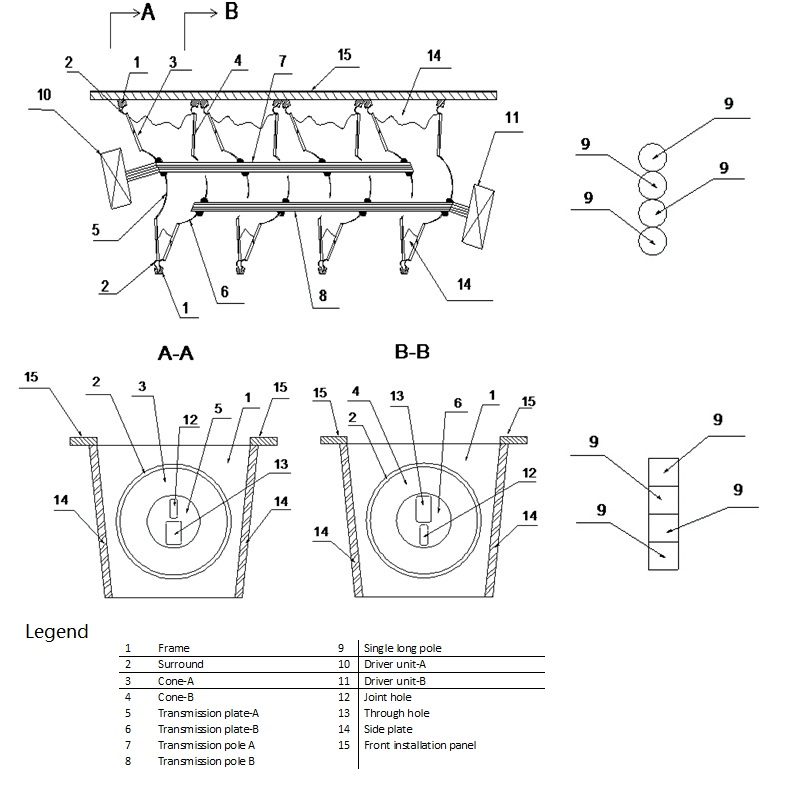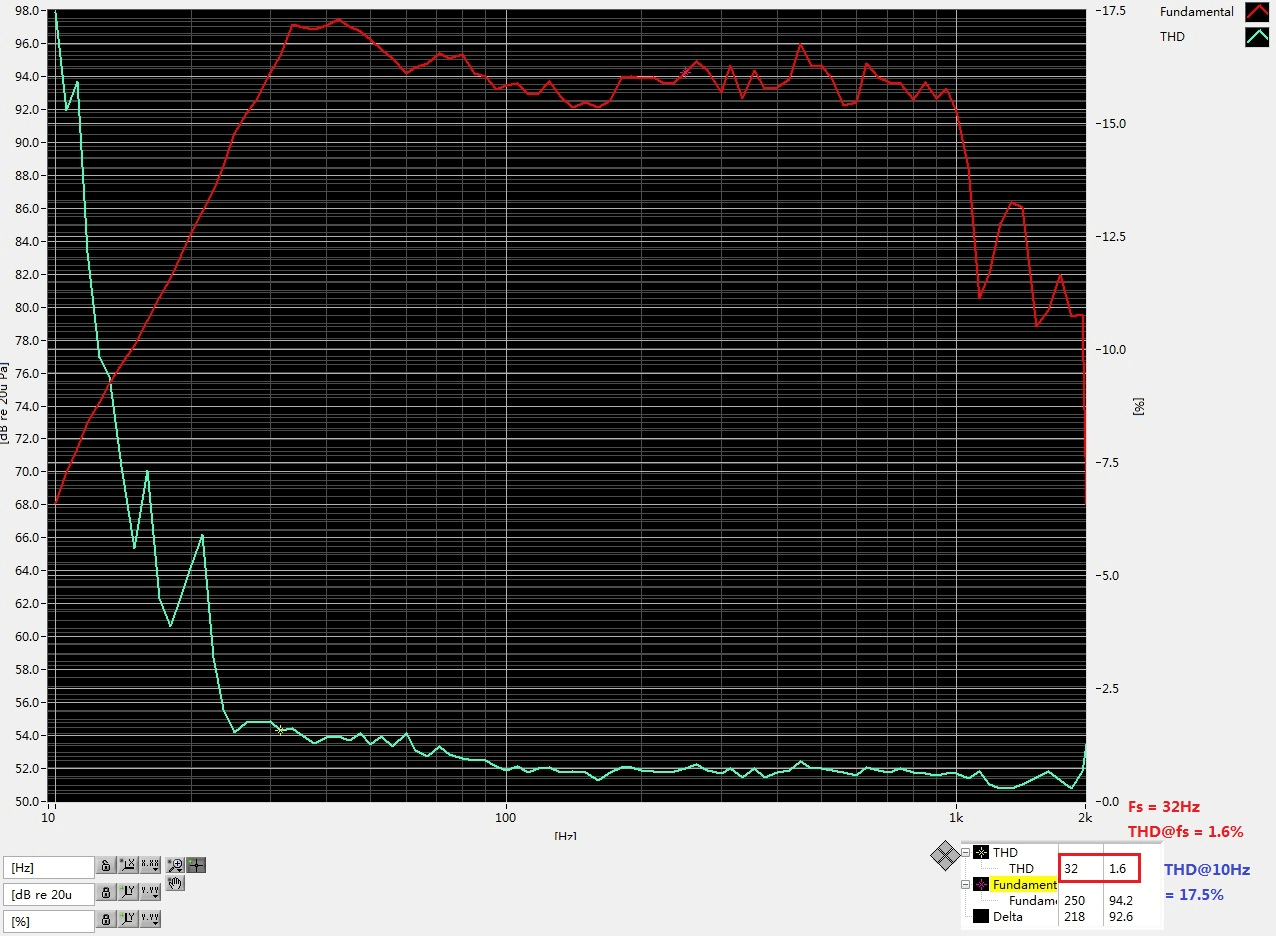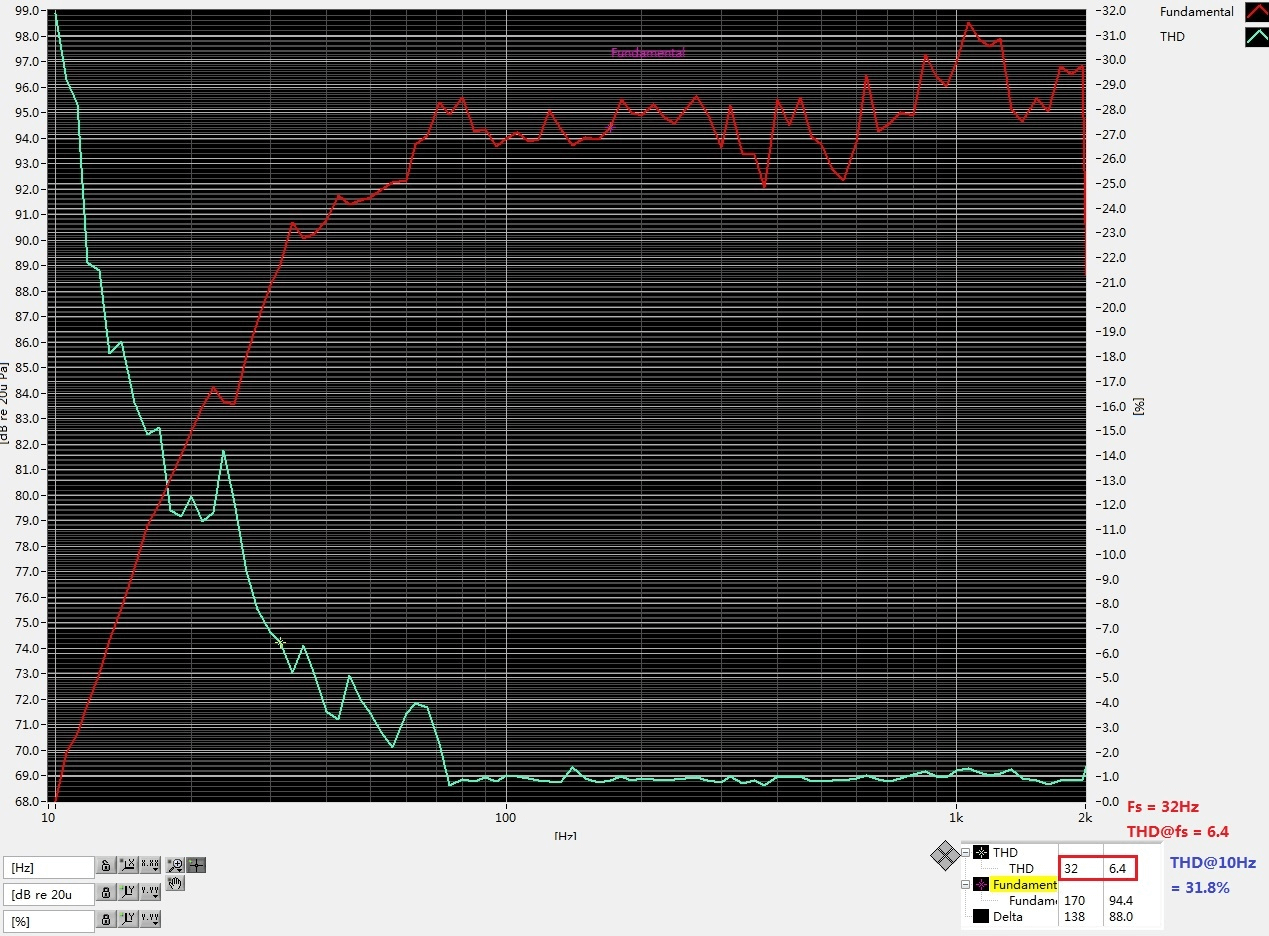
DDQ CURRENT MODELS
- DDQ5-2: 42 - 1600Hz(-3dB), 86dB(1m*1W), Rated Power 60W.
- DDQ6-2: 34 - 1300Hz(-3dB), 87dB(1m*1W), Rated Power 60W.
- DDQ8-2: 27 - 1150Hz(-3dB), 88dB(1m*1W), Rated Power 100W.
- DDQ10-2: 21Hz - 1100Hz(-3dB), 89dB(1m*1W), Rated Power 100W.
DESIGN PRINCIPLES
The DDQ is the acronym of Chinese Pinyin 'Duolian Duichen Qudong', which in English means 'Multi-folded Symmetrical Driving Technology'. Its structure is totally different from the traditional woofers. Its working principle is very similar to Dr. Heil's(The inventor of AMT, American Dr. Oscar Heil) AMT TWEETER. We successfully bring the AIR MOTION principle to our woofer design by our unique patented structures.
The DDQ's patented and unique design mainly comprises of these parts below:
1. Several 'V' type components which mainly comprises of two cone frames and two cones. The bottem and two sides of the 'V' type components are sealed, which means the 'V' type component only has one outlet;
2. Two driving unit installed symmetrically on the DDQ's two ends, the driving unit mainly contains magnet path, voice coil and the two units could be parallel connection or series connection;
3. Two specially designed high rigidity driving poles go through each 'V' type component's center;
4. The two driving poles are driven separately by one driving unit that is installed on the DDQ's end;
5. Each driving pole drives only one cone in each 'V' type component it goes through. It means that, if the DDQ woofer has two 'V' type components, one driving pole drives two cones at the same time;
When the DDQ is working, the two symmetrical driving units push and pull the two cones simultaneouly in each 'V' type component by the two driving poles, and then the two cones in every 'V' type component move in the opposite direction. Through this motion, the air is just pulled in or pushed out to produce sound. Compared with traditional cone-type woofers , the DDQ has specific compression-ratio due to its 'V' type component. Under the same outlet area, the DDQ has much better bass performance, much greater dynamic range!
STRUCTURE FEATURES

PERFORMANCE FEATURES
1. The DDQ's practical low end limit is its F0(aka Fs) point, please notice that its SPL has no roll-off on its F0 point. Usually, a traditional woofer will has a typical 3~6 dB roll-off at its F0. With smaller caliber, the roll-off gets sharper! For examples: the model 'DDQ5-2' has its F0 at 60Hz while its SPL has no roll-off at 60Hz and -3dB at 42Hz. The model 'DDQ6-2' has its F0 at 55Hz while its SPL has no roll-off at 55Hz and -3dB at 34Hz. The model 'DDQ8-2' has its F0 at 32Hz while its SPL has no roll-off at 32Hz and -3dB at 27Hz.
2. The DDQ adopts a symmetrical driving structure. So the motion direction between the adjacent cone is opposite thus results in a nearly zero resultant forces. When installed in the speaker box, it brings very slight vibration on the baffle. So the bass quality is much purer! On the contrast the traditional woofer has much greater counterforce.
3. The DDQ has several 'V' type componentss and each 'V' type components acts as a sound source when it works. In each 'V' type components it has two cones that are driven by separate driving poles in opposite direction. When DDQ works these two cones in each 'V' component will pull-in or push-out the air to produce the sound. Because this 'V' type component has particular compression ratio, in the low freq range the DDQ has much better power compression performance than traditional woofers.
4. The DDQ's THD level above 100Hz is very similar with traditional woofers but its has obviously much lower THD level from F0(aka Fs) to 100Hz. Traditional woofers' THD level increases gradually from 100Hz to F0 and grows rapidly as it comes nearly to F0. Normally speaking, if a traditional woofer has 1% THD level at 100Hz then it will grow up to 5%(or even higher) at its Fs. The DDQ has a similar THD level at 100Hz (about 1%) and it grows up to 2.5% roughly. In real listening test the DDQ could produce much better powererful, lower and purity bass. Please check the testing results below.
Under the same test conditions we used SoundCheck system to do the THD test on both DDQ and traditional woofers and we got the data below(here we use 'TW' as 'traditional woofers' for short):
| DDQ's THD@10Hz | TW's THD@10Hz | DDQ's THD@Fs | TW's THD@Fs | |
|---|---|---|---|---|
| DDQ8-2 vs. 8inch TW | 17.5% | 31.8% | Fs=32Hz, 1.6% | Fs=32Hz, 6.4% |
| DDQ6-2 vs. 6inch TW | 13.6% | 40.8% | Fs=50Hz, 2.3% | Fs=63Hz, 2.3% |
| DDQ5-2 vs. 5inch TW | 21.7% | 64.7% | Fs=60Hz, 3.0% | Fs=63Hz, 3.7% |
Note:
1. TW: The abbreviation of 'Traditional Woofer', here we use it just for short. Similarly hereinafter.
2. Click the pictures to enlarge.
3. The left scale is SPL (sound pressure) and the right scale is the THD (%).

Fig.1 DDQ8-2 SPL(94dB) vs. THD(SoundCheckTM) curves

Fig.2 8inch TW SPL(94dB) vs THD(SoundCheckTM) curves
Other comparisons:
NOTICE
After reading all the info we described above, an experienced speaker designer must have a question -- 'The depth of the DDQ's "V"-type structure would cause severe front-chamber-effect thus results in big fluctuation in response(especially in high frequency range), how do you fix this problem?'
Yes! The 'front-chamber' effect really exist in the early prototypes of DDQ and gave a bad impact on the response. After many analysis and experiments we successfully solve this problem by adding arrays of regular and optimized rectangular holes(we called these holes as 'Q-damping' hole) in every side plate of the 'V'-type structure and we filled these holes with damping materials. This measurement fixes this problem effectively. The 'front-chamber' effect has been deminished greatly without affecting the whole performance and the response of DDQ in mid-high range just becomes as flat as traditional woofers'.
Currently DDQ series has four models:
- DDQ5-2:2 sets of 'V' sub-structures with two 5-inch cones in each 'V' sub-structures(frequency limit:42Hz(-3dB) Rated Power: 60W).
- DDQ6-2:2 sets of 'V' sub-structures with two 6-inch cones in each 'V' sub-structures(frequency limit:34Hz(-3dB) Rated Power: 60W).
- DDQ8-2:2 sets of 'V' sub-structures with two 8-inch cones in each 'V' sub-structures(frequency limit:27Hz(-3dB) Rated Power: 100W).
- DDQ10-2:2 sets of 'V' sub-structures with two 10-inch cones in each 'V' sub-structure(frequency limit:21Hz(-3dB) Rated Power: 100W).